How Often to Water a Snake Plant: A Complete Guide
Snake plants are known for being low-maintenance, but proper watering is key to keeping them healthy. Too much water can rot the roots, and too little can make the leaves dry and droopy. The key is finding the right balance.
If you are a snake plant lover and want them to grow well, you might wonder how often to water a snake plant. What should you do? Don’t worry! I’m here to explain everything—when, how, and how much to water your plant.
Let’s break it down step by step.
Table of Contents
Understanding Snake Plant Watering Needs

Water plays a key role in a snake plant’s health. It helps transport nutrients, keeps the leaves hydrated, and prevents wilting. Snake plants store water in their thick leaves, so they don’t need frequent watering. The proper snake plant watering schedule keeps them thriving with minimal care.
Overwatering is the biggest threat to snake plants. Too much water can lead to root rot, yellowing leaves, and mushy stems. On the other hand, underwatering can cause dry, curling leaves and slow growth. The key to proper snake plant watering is to let the soil dry out between waterings and adjust based on the season.
Signs Your Snake Plant Needs Water

Knowing when to water a snake plant is important to keep it healthy. Since snake plants don’t need frequent watering, it’s easy to forget when they need a drink. Here are the key signs that your snake plant needs water:
- Dry soil – If the top 1-2 inches of soil feel completely dry, it’s time to water.
- Wrinkled or curling leaves – Leaves may curl or wrinkle when they lack moisture.
- Drooping leaves – A thirsty snake plant can look weak, with leaves bending or drooping.
- Brown or crispy edges – Dry tips and edges mean the plant is dehydrated.
- Slow growth – If your snake plant isn’t growing, it may not be getting enough water.
- Light, loose soil – When the soil pulls away from the pot’s edges, it’s too dry.
- Dull or pale leaves – A well-hydrated snake plant has firm, vibrant leaves. Dry plants may look faded.
- Time since last watering – If it has been 2-3 weeks since the last watering, your plant may need water. In warmer months, it may need water a bit sooner.
If you notice these signs, it’s a good time to water your snake plant. Always check the soil first to avoid overwatering.
Factors Influencing Watering Frequency
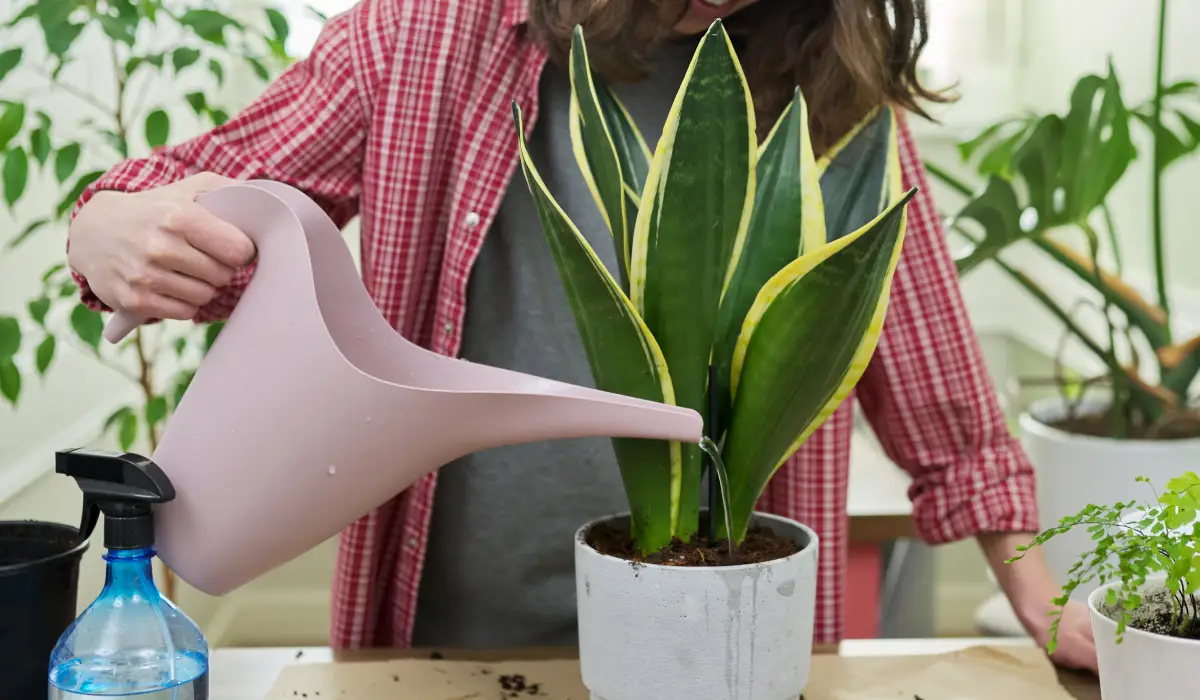
How often you water a snake plant depends on several factors. Understanding these helps prevent overwatering or underwatering. Here are the key factors that affect snake plant watering needs:
Climate and seasonality
The weather plays a big role in watering frequency. In warm and dry seasons, snake plants lose moisture faster and need more water. In winter, they grow slower and need less water. If the air is humid, the soil stays moist longer, reducing the need for frequent watering.
Pot size and drainage
The size and type of pot matter. Small pots dry out faster than large ones, so they may need water more often. Good drainage is also important. Pots with drainage holes let excess water escape, preventing root rot. Without drainage, water stays in the soil longer, increasing the risk of overwatering.
Soil type and composition
Well-draining soil is essential for snake plant watering. A mix with sand, perlite, or cactus soil helps excess water drain quickly. Heavy or compact soil holds too much moisture, leading to root problems. Choosing the right soil ensures your plant gets the right balance of water and air.
Light exposure and indoor conditions
Snake plants in bright, indirect light dry out faster than those in low light. If your plant gets a lot of sunlight, it may need water more often. Indoor conditions like heating, air conditioning, or airflow also impact soil moisture. Rooms with dry air can cause the soil to dry out quickly, while humid environments keep it moist longer.
How Often to Water Snake Plants?
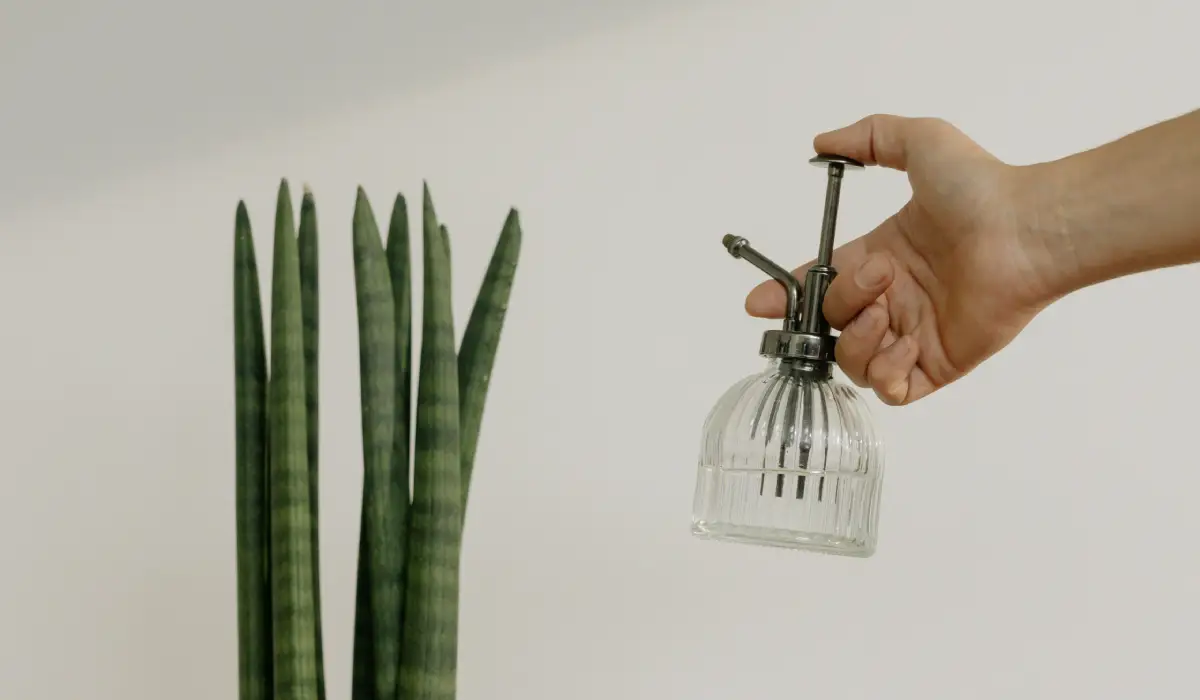
Your beloved plant doesn’t need frequent watering. But, the right watering schedule for snake plants is important for their thriving.
Watering frequency in Summer vs. Winter
Summer: Snake plants grow actively in warm months and need more water. Water them every 1-2 weeks, depending on how fast the soil dries. Hotter temperatures and increased sunlight make the soil dry out faster. Always check the top 1-2 inches of soil before watering.
Winter: Growth slows down in colder months, so the plant needs less water. Water every 3-4 weeks or when the soil is completely dry. Overwatering in winter can cause root rot because the plant takes longer to absorb moisture.
Adjust your watering schedule based on the season and indoor conditions.
How Much to Water Snake Plant?
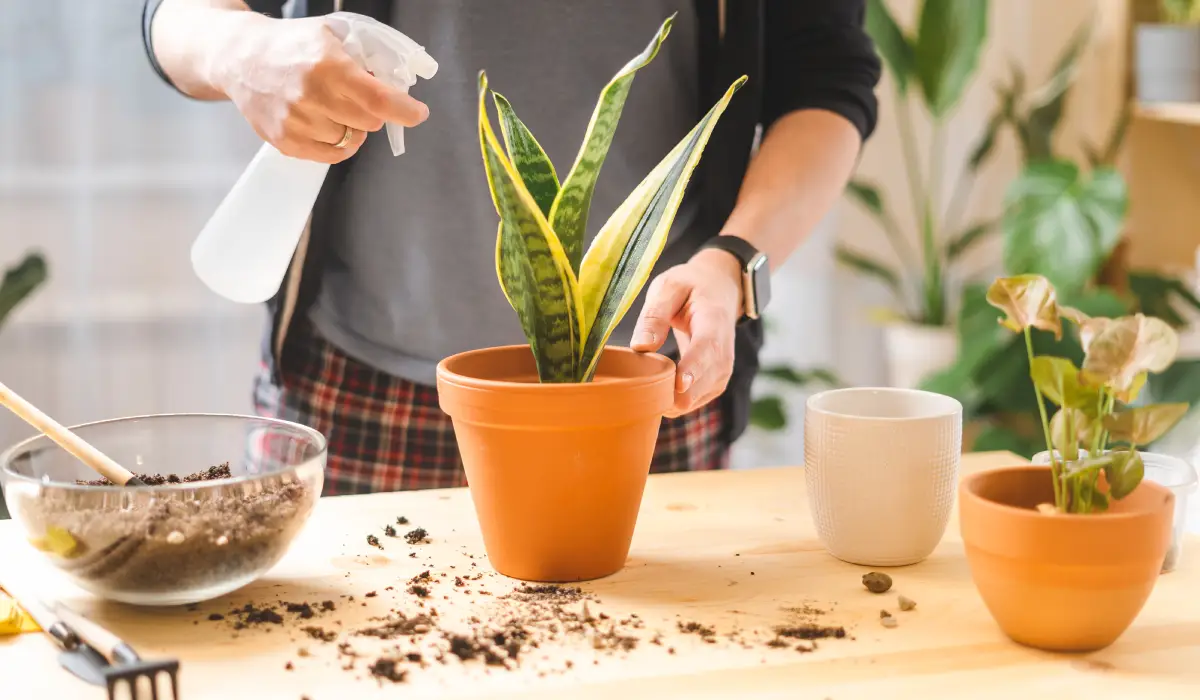
Giving your snake plant the right amount of water helps it stay healthy and grow well. Instead of watering on a strict schedule, it’s best to focus on the soil’s moisture level and use the right watering method.
Measuring water quantity
Snake plants need just enough water to moisten the soil without making it soggy. For small pots, ¼ to ½ cups of water is usually enough. Larger pots may need 1 cup or more, depending on the size and soil dryness. Always check the soil first—if the top 1-2 inches are dry, it’s time to water.
The "Soak and Dry" method
A simple and effective way to water a snake plant is the soak-and-dry method. Slowly pour water into the soil until you see excess water draining from the bottom. This ensures the roots get enough moisture without sitting in water. After watering, wait until the soil is completely dry before watering again. This method prevents water buildup and supports healthy root growth.
How to Water Snake Plants Correctly?
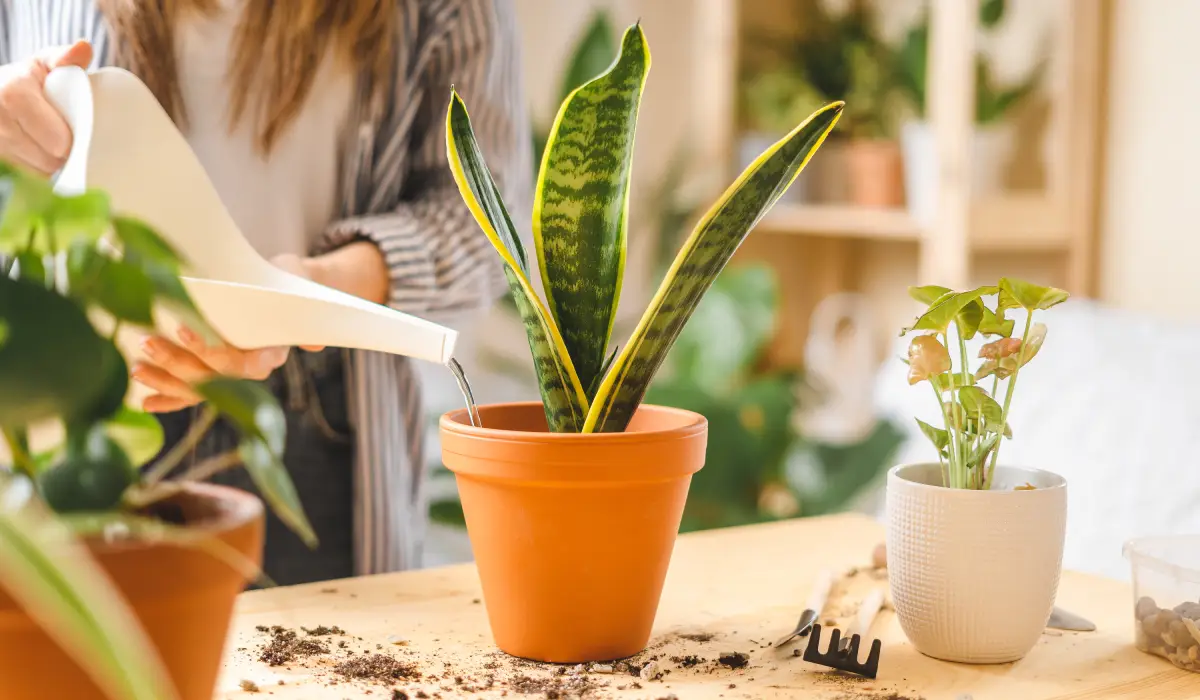
Watering your snake plant the right way helps keep it healthy and prevents problems like root rot or dehydration. Follow my step-by-step simple process to ensure proper watering.
- Check the soil – Before watering, touch the top 1-2 inches of soil. If it feels dry, it’s time to water. If it’s still moist, wait a few more days.
- Use the right amount of water – For small pots, use ¼ to ½ cups of water. For larger pots, use 1 cup or more, depending on the soil dryness.
- Water evenly – Pour water slowly around the base of the plant, not just in one spot. Avoid getting water on the leaves.
- Let excess water drain – If your pot has drainage holes, allow extra water to flow out. Never let the plant sit in standing water.
- Empty the saucer – If water collects in a saucer under the pot, dump it out to prevent root rot.
- Wait for the soil to dry – Let the soil dry completely before watering again. This usually takes 1-2 weeks in summer and 3-4 weeks in winter.
Common Watering Mistakes to Avoid

Proper snake plant watering is simple, but some common mistakes can harm your plant. Avoid these errors to keep your snake plant healthy.
Overwatering and root rot
Giving too much water is the most common mistake. Snake plants store water in their leaves, so they don’t need frequent watering. Overwatering can cause root rot, making the roots soft and black. Always let the soil dry out before watering again.
Watering on a fixed schedule
Watering on a strict schedule can lead to problems. Instead of watering every few days, check the soil first. If the top 1-2 inches are dry, it’s time to water. If not, wait a little longer. Snake plant watering should be based on soil dryness, not a calendar.
Ignoring seasonal changes
Snake plants need more water in warm months and less in winter. If you water the same way year-round, you may overwater in winter or underwater in summer. Adjust watering based on temperature, humidity, and plant growth.
Symptoms of Overwatering
I’ve been in love with snake plants for 7 years. In these 7 years, I’ve experienced several overwatering symptoms. Like,
- Yellowing leaves
- Soft or mushy leaves
- Leaves drooping or wilting
- Brown or black roots
- Mold or fungus on soil
- Rotten smell from soil
- Blisters or water-soaked patches
- Stunted growth
- Pests Like fungus gnats
Symptoms of Underwatering
In this world, we all learn from our mistakes. I’m no different. Whenever I saw signs of overwatering, I stopped watering my snake plant for weeks or even months. Then, I started noticing signs of underwatering. Like,
- Wrinkled or curling leaves
- Dry, crispy leaf tips
- Slow or no growth
- Drooping or weak leaves
- Brittle or cracking leaves
- Soil pulling away from the pot
- Lightweight pot
- Faded or dull leaf color
Tips for Maintaining a Healthy Snake Plant
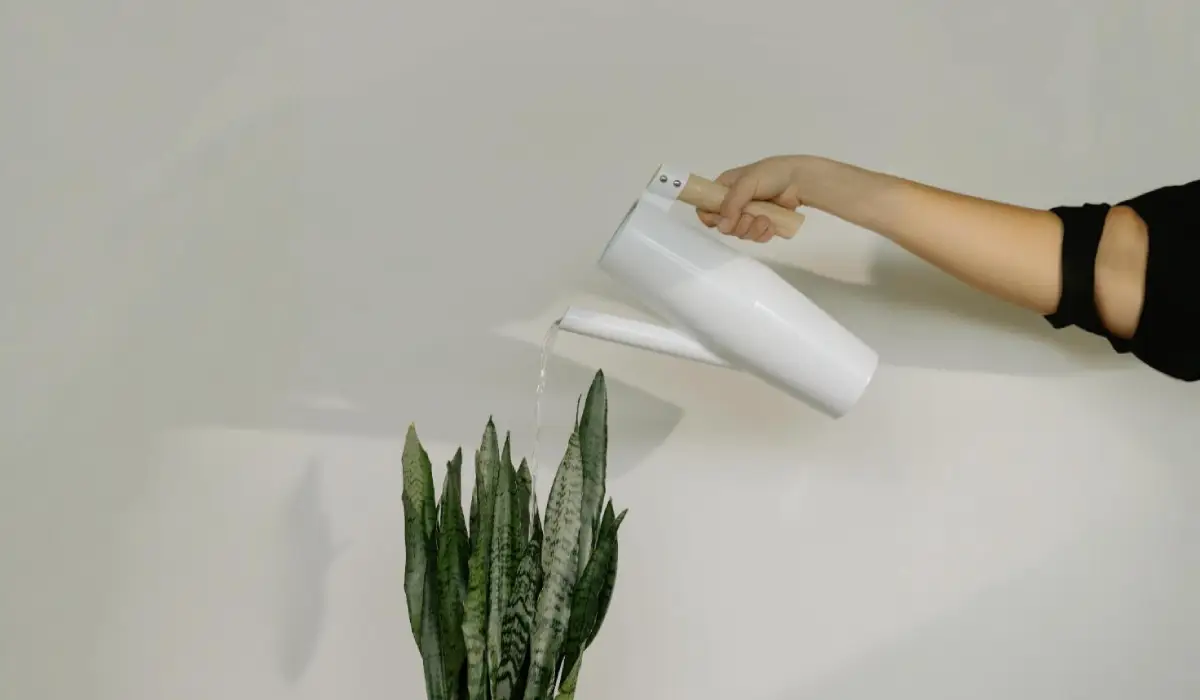
Keeping your snake plant healthy is easy with the right care. Start by choosing a well-draining pot with drainage holes and using a light, airy soil mix to prevent water buildup.
A moisture meter can help you check when the soil is dry enough for watering so you don’t overwater or underwater.
When fertilizing, use a diluted liquid fertilizer once every 1-2 months during the growing season, but avoid overwatering in the process.
Lastly, clean the leaves regularly with a damp cloth to remove dust. This helps the plant absorb more light for better photosynthesis and growth.
Final Takeaways
These are the key points to remember about how often to water a snake plant.
Keeping your snake plant healthy doesn’t have to be complicated. Remember, these plants thrive on neglect rather than overcare. Think about their natural habitat—dry, arid conditions where water is scarce. By mimicking those conditions, you’ll set your snake plant up for success.
A little attention to detail goes a long way. Check the soil, adjust for seasons, and always err on the side of underwatering rather than overwatering. With these tips in mind, you’ll be well-equipped to keep your snake plant thriving and looking its best for years to come.
So, there you have it—mastering snake plant watering is simple when you know the basics. Happy planting!
FAQs
Yes, but let it sit for 24 hours to allow chlorine and chemicals to evaporate. If your tap water has high minerals, use filtered or distilled water to prevent leaf damage.
Remove the plant from soggy soil and trim any rotting roots. Let it dry for a day, then repot in fresh, well-draining soil. Water lightly and wait until the soil fully dries before watering again.
Underwatering is safer. Snake plants store water in their leaves and can survive dry periods. Overwatering causes root rot, which is harder to fix. Always let the soil dry before watering.
